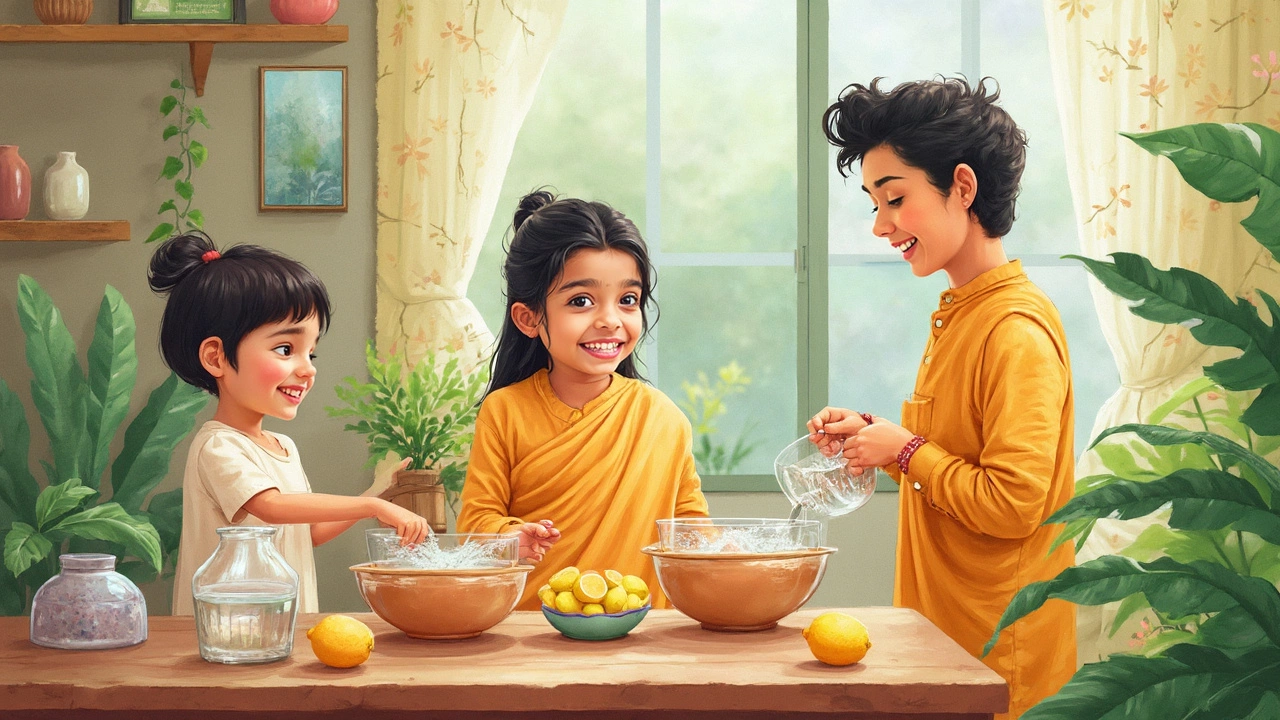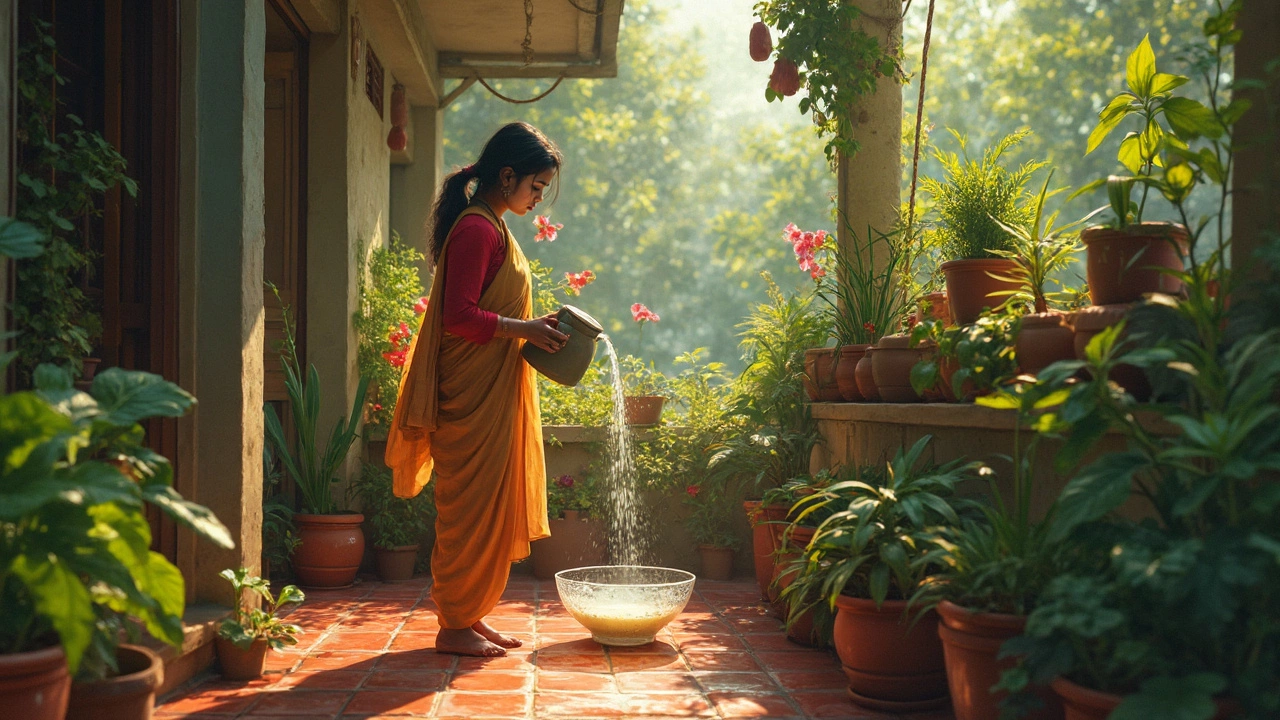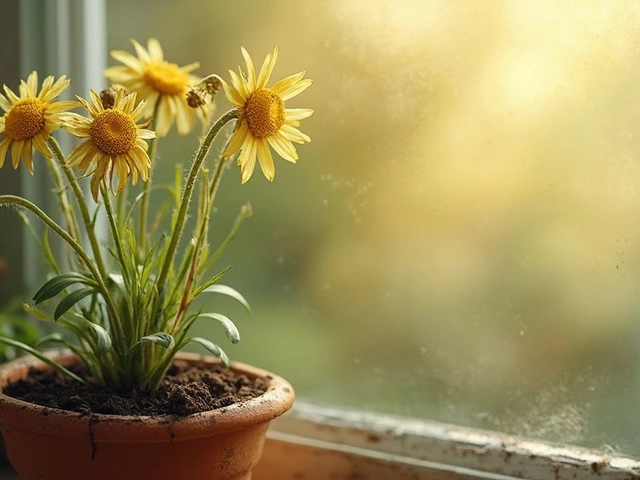Ever checked your plants and wondered why they look a bit droopy, even though you’re watering them just right? Tap water might be the culprit. Most tap water isn’t pure—there’s chlorine to kill germs, and sometimes hard minerals or other sneaky stuff. Great for people, not so much for houseplants.
Your leafy friends love their water with a neutral pH, but tap water swings too high or low. Chlorine and fluoride can stunt growth, and all that limescale from hard water shows up as crusty white marks on your pots. Not exactly the lush look you were going for.
Luckily, making your tap water plant-friendly is easier than you think. With a couple of easy tricks—like letting water sit out or using everyday kitchen stuff—you can cut out the harsh additives. Stronger roots, greener leaves, and fewer mystery spots on your favorite monstera are totally within reach.
- Why Tap Water Can Harm Houseplants
- Signs Your Plants Hate Tap Water
- Simple Ways to Neutralize Tap Water
- Best Tools for Hassle-Free Water Prep
- Bonus Tips for Happier Indoor Plants
Why Tap Water Can Harm Houseplants
If you’ve ever wondered why your indoor plants sometimes look sad even though you water them on schedule, the answer could be the tap water. Tap water is fine for humans, but it often comes loaded with additives and minerals that can mess with your plant’s health.
The top issue? Neutralize tap water—plain tap water usually has chlorine or chloramine, which are added to protect us from germs but can be rough on delicate plant roots. Over time, these chemicals stop your plants from soaking up nutrients and sometimes even damage leaf tips.
It’s not just about chemicals. Many homes have “hard” water, meaning it’s high in calcium and magnesium. Those minerals build up in the soil and can throw off the nutrient balance. You might spot this as white crust on the soil surface or pot edges. Some city water is also a bit too alkaline or acidic, which interferes with your plant’s ability to absorb what it needs.
Here’s a quick look at what might be chilling in your tap water and how it stacks up to what houseplants actually need:
| Common Tap Water Component | Plant-Friendly or Not? | What It Causes |
|---|---|---|
| Chlorine | Not plant-friendly | Leaf burn, slowed growth |
| Chloramine | Not plant-friendly | Root damage over time |
| Fluoride | Not plant-friendly | Brown leaf tips, spots |
| Calcium/Magnesium (Hard Water) | Too much is bad | White crusts, poor nutrient absorption |
| High pH | Not ideal | Nutrient deficiencies |
So, while your tap water might look crystal clear, it can quietly build up in your plant’s soil and roots, causing issues that don’t always show up right away. Plants aren’t dramatic—they’ll slowly lose their shine or stop growing well. Sometimes, all it takes is switching the way you water to give them a real boost.
Signs Your Plants Hate Tap Water
When your houseplants start to look unhappy, tap water can be the sneaky reason. Plants aren’t shy about showing their dislike, but it’s easy to miss the signs if you don’t know what to look for. Here’s how to spot the red flags that tell you your indoor plants aren’t getting along with your everyday watering routine.
- Leaf Tips Turning Brown: If your plants have crispy brown tips or edges, chlorine and fluoride in tap water might be the problem. This is super common with popular houseplants like spider plants and peace lilies.
- Weird Yellow Patches: Extra minerals, especially calcium and magnesium, can mess with how your plants take up nutrients, leading to yellow spots or blotches across the leaves, not just on the edges.
- White Crusty Residue: Notice a chalky, white buildup on the surface of your soil or around the pot rim? That’s usually mineral buildup from hard tap water.
- Slower Growth or Droopy Leaves: Plants watered with untreated tap water can look limp or have stunted growth. They might even shed older leaves faster than usual.
- Leaf Drop: Sensitive varieties, like calatheas or some ferns, can start dropping leaves if their roots can’t handle the tap water’s additives.
If you’re seeing these issues, you’re not alone—a 2023 survey found 48% of indoor gardeners struggled with water-related plant problems at least once a year. Check out the types of common symptoms and what usually causes them:
| Symptom | Likely Culprit | Most Affected Plant Types |
|---|---|---|
| Brown leaf tips | Chlorine or fluoride | Spider plant, Peace lily |
| White residue on soil | Mineral buildup | All types |
| Yellow patches | Imbalanced pH or minerals | Fiddle leaf fig, Pothos |
| Stunted growth | Chemical sensitivity | Calathea, Ferns |
If you spot more than one of these symptoms, your tap water probably needs some tweaking. Luckily, getting on top of your neutralize tap water game can turn things around fast for your green crew.

Simple Ways to Neutralize Tap Water
If you’re dealing with stubborn tap water, you have a handful of easy fixes. Most take just a bit of patience or stuff you already have at home. Here’s how you can make your everyday water friendlier for your plants in no time:
- Let It Sit Out: Pour tap water into an open bucket or watering can and let it stand out overnight (24 hours is even better). This lets chlorine gas off-gas, which makes water safer for those sensitive roots. Don’t cover the container—it needs air contact to work.
- Boil and Cool: Boiling water drives off most of the chlorine and can reduce hardness just a smidge. Just remember to let the water cool all the way down before pouring it out for your plants. Scalded roots are even worse than tap water!
- Use a Cheap Water Filter: Simple pitcher filters (think Brita or ZeroWater) pull out chlorine and some heavy metals. Plants don’t need fancy setups—a $20 filter is often enough for great results.
- Add Vitamin C: This one surprises people, but a pinch of powdered vitamin C (ascorbic acid) destroys chlorine. Experts at the San Francisco Public Utilities Commission suggest, “Adding just 1 gram of vitamin C to 10 gallons of water takes care of chlorine and chloramine quickly.” Easy and safe.
- Adjust the pH: If your tap water pH is way out of whack (7.5+ for hard water areas), a drop or two of lemon juice or a splash of white vinegar brings it back closer to neutral. But use a pH strip to check—just guessing isn’t worth the risk.
“Chlorine and chloramine can cause leaf tip burn and slow growth. Neutralizing tap water is an easy way to prevent unnecessary stress on your houseplants.” – The Indoor Plant Society
Check out some numbers—tap water quality can range a lot from city to city:
| City | Avg. Tap Water pH | Chlorine (mg/L) |
|---|---|---|
| Los Angeles | 8.0 | 0.8 |
| Chicago | 7.5 | 1.2 |
| New York | 7.2 | 0.7 |
So, if you live somewhere with hard water, chances are you’ll need to pay just a little more attention to how you treat it. Neutralizing your tap water might sound fussy, but it’s honestly like giving your plants a mini spa day—and you’ll probably notice the difference within a few weeks. Small changes, big payoff for your green crew.
Best Tools for Hassle-Free Water Prep
Getting tap water safe for your plants doesn’t need to feel like a science experiment. There are a few tools that can make the job way easier, save you time, and help your plants thrive.
If you want to keep things simple, start with a basic water filter pitcher. These filter out a lot of chlorine and minerals that bug most houseplants. Brands like Brita or PUR are popular for a reason—they’re easy to use and you don’t need any plumbing skills to set them up. Just fill and pour.
Measuring pH sounds fancy, but a handheld pH meter is honestly a game-changer. Amazon sells basic digital ones for less than $20. You pop it in your water, get a clear number, and know if you need to tweak anything. Too high? Add a splash of white vinegar. Too low? Crushed eggshells can help bump it up. No guessing, just solid numbers.
For folks with a bunch of plants, a reverse osmosis (RO) filter is a step up. This takes almost everything out of your water—chlorine, fluoride, heavy metals, the works. Installation takes a bit more effort and the price is higher, but the water is about as pure as you can get from a tap. Some people use RO just for their fussy plants, like orchids or carnivorous varieties.
- Water filter pitchers: quick fix for regular use, removes most of the bad stuff.
- Digital pH meter: track the neutralize tap water process so you don’t mess up your plants’ pH.
- RO filter system: super clean option for serious indoor gardeners.
- Watering cans with measurement lines: helps track how much treated water you’re actually using—no more mystery pours.
If you’re on a tight budget, just use a clean bucket and leave water out overnight. Most of the chlorine will evaporate by morning. Not as high-tech as fancy gadgets, but it works!

Bonus Tips for Happier Indoor Plants
Giving your plants the right water is a good start, but they need a bit more to really thrive. Here are some bonus hacks to boost their mood and growth indoors.
- Neutralize tap water with rainwater now and then. If you can collect rainwater, your plants will love the minerals and lack of chemicals—it’s their natural drink!
- Rotate your pots every week. Indoor plants lean toward sunlight, so turning them keeps their growth even and stops that lopsided look.
- Wipe dust off the leaves once a month. Dust clogs up their pores and blocks sunlight. A damp cloth is all you need for most houseplants.
- Let water sit to room temp before watering. Cold water from the tap can shock roots, especially with tropical plants like calatheas and monsteras.
- Feed them, but don’t overdo it. Most indoor plants need fertilizer only during spring and summer, and just a mild mix. Overfeeding is a common mistake indoors.
If you’re not sure your plants are getting enough humidity, bunch them together or set up a shallow tray of water nearby (not under the pot). This bumps up the local moisture—super helpful in winter when the heater kicks in.
| Tip | Why It Matters | How Often |
|---|---|---|
| Water with neutral pH | Prevents root burn | Every watering |
| Dust leaves | Boosts photosynthesis | Monthly |
| Rotate plant pot | Even growth | Weekly |
| Fertilize lightly | Promotes healthy growth | Spring & Summer |
| Raise humidity | Prevents crispy leaves | When air is dry |
Following these steps won’t just keep your plants alive—they’ll stay healthier, look brighter, and bounce back quicker from little problems. That’s what makes indoor gardening fun instead of frustrating.




